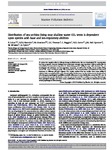Distribution of sea urchins living near shallow water CO(2) vents is dependent upon species acid-base and ion-regulatory abilities.
| dc.contributor.author | Calosi, P | |
| dc.contributor.author | Rastrick, SP | |
| dc.contributor.author | Graziano, M | |
| dc.contributor.author | Thomas, SC | |
| dc.contributor.author | Baggini, C | |
| dc.contributor.author | Carter, HA | |
| dc.contributor.author | Hall-Spencer, Jason | |
| dc.contributor.author | Milazzo, M | |
| dc.contributor.author | Spicer, John | |
| dc.date.accessioned | 2013-04-17T15:24:42Z | |
| dc.date.available | 2013-04-17T15:24:42Z | |
| dc.date.issued | 2013-02-18 | |
| dc.identifier.issn | 0025-326X | |
| dc.identifier.issn | 1879-3363 | |
| dc.identifier.uri | http://hdl.handle.net/10026.1/1450 | |
| dc.description | The version on PEARL: Corrected proofs are Articles in Press that contain the authors' corrections. Final citation details, e.g., volume/issue number, publication year and page numbers, still need to be added and the text might change before final publication. Although corrected proofs do not have all bibliographic details available yet, they can already be cited using the year of online publication and the DOI , as follows: author(s), article title, journal (year), DOI. | |
| dc.description.abstract |
To reduce the negative effect of climate change on Biodiversity, the use of geological CO(2) sequestration has been proposed; however leakage from underwater storages may represent a risk to marine life. As extracellular homeostasis is important in determining species' ability to cope with elevated CO(2), we investigated the acid-base and ion regulatory responses, as well as the density, of sea urchins living around CO(2) vents at Vulcano, Italy. We conducted in situ transplantation and field-based laboratory exposures to different pCO(2)/pH regimes. Our results confirm that sea urchins have some ability to regulate their extracellular fluid under elevated pCO(2). Furthermore, we show that even in closely-related taxa divergent physiological capabilities underlie differences in taxa distribution around the CO(2) vent. It is concluded that species distribution under the sort of elevated CO(2) conditions occurring with leakages from geological storages and future ocean acidification scenarios, may partly be determined by quite subtle physiological differentiation. | |
| dc.format.extent | 470-484 | |
| dc.format.medium | Print-Electronic | |
| dc.language | ENG | |
| dc.language.iso | ENG | |
| dc.publisher | Elsevier BV | |
| dc.subject | Carbon capture and storage (CCS) | |
| dc.subject | Ocean acidification | |
| dc.subject | Arbacia lixula | |
| dc.subject | Paracentrotus lividus | |
| dc.subject | Acid-base and ionic regulation | |
| dc.subject | Distribution | |
| dc.title | Distribution of sea urchins living near shallow water CO(2) vents is dependent upon species acid-base and ion-regulatory abilities. | |
| dc.type | journal-article | |
| dc.type | Article | |
| plymouth.author-url | http://www.ncbi.nlm.nih.gov/pubmed/23428288 | |
| plymouth.issue | 2 | |
| plymouth.volume | 73 | |
| plymouth.publication-status | Published | |
| plymouth.journal | Mar Pollut Bull | |
| dc.identifier.doi | 10.1016/j.marpolbul.2012.11.040 | |
| plymouth.organisational-group | /Plymouth | |
| plymouth.organisational-group | /Plymouth/Faculty of Science and Engineering | |
| plymouth.organisational-group | /Plymouth/Faculty of Science and Engineering/School of Biological and Marine Sciences | |
| plymouth.organisational-group | /Plymouth/PRIMaRE Publications | |
| plymouth.organisational-group | /Plymouth/REF 2021 Researchers by UoA | |
| plymouth.organisational-group | /Plymouth/REF 2021 Researchers by UoA/UoA07 Earth Systems and Environmental Sciences | |
| plymouth.organisational-group | /Plymouth/Research Groups | |
| plymouth.organisational-group | /Plymouth/Research Groups/Marine Institute | |
| plymouth.organisational-group | /Plymouth/Users by role | |
| plymouth.organisational-group | /Plymouth/Users by role/Academics | |
| dc.publisher.place | England | |
| dcterms.dateAccepted | 2012-11-22 | |
| dc.identifier.eissn | 1879-3363 | |
| dc.rights.embargoperiod | Not known | |
| rioxxterms.funder | Natural Environment Research Council | |
| rioxxterms.identifier.project | Impacts of ocean acidification on key benthic ecosystems, communities, habitats, species and life cycles | |
| rioxxterms.versionofrecord | 10.1016/j.marpolbul.2012.11.040 | |
| rioxxterms.licenseref.uri | http://www.rioxx.net/licenses/all-rights-reserved | |
| rioxxterms.type | Journal Article/Review | |
| plymouth.funder | Impacts of ocean acidification on key benthic ecosystems, communities, habitats, species and life cycles::Natural Environment Research Council |


